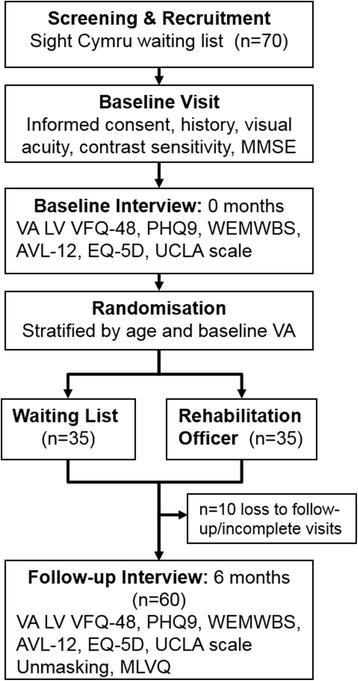Effect of rehabilitation worker input on visual function outcomes in individuals with low vision: study protocol for a randomised controlled trial
- PMID: 26908153
- PMCID: PMC4765130
- DOI: 10.1186/s13063-016-1235-2
Effect of rehabilitation worker input on visual function outcomes in individuals with low vision: study protocol for a randomised controlled trial
Abstract
Background: Visual Rehabilitation Officers help people with a visual impairment maintain their independence. This intervention adopts a flexible, goal-centred approach, which may include training in mobility, use of optical and non-optical aids, and performance of activities of daily living. Although Visual Rehabilitation Officers are an integral part of the low vision service in the United Kingdom, evidence that they are effective is lacking. The purpose of this exploratory trial is to estimate the impact of a Visual Rehabilitation Officer on self-reported visual function, psychosocial and quality-of-life outcomes in individuals with low vision.
Methods/design: In this exploratory, assessor-masked, parallel group, randomised controlled trial, participants will be allocated either to receive home visits from a Visual Rehabilitation Officer (n = 30) or to a waiting list control group (n = 30) in a 1:1 ratio. Adult volunteers with a visual impairment, who have been identified as needing rehabilitation officer input by a social worker, will take part. Those with an urgent need for a Visual Rehabilitation Officer or who have a cognitive impairment will be excluded. The primary outcome measure will be self-reported visual function (48-item Veterans Affairs Low Vision Visual Functioning Questionnaire). Secondary outcome measures will include psychological and quality-of-life metrics: the Patient Health Questionnaire (PHQ-9), the Warwick-Edinburgh Mental Well-being Scale (WEMWBS), the Adjustment to Age-related Visual Loss Scale (AVL-12), the Standardised Health-related Quality of Life Questionnaire (EQ-5D) and the UCLA Loneliness Scale. The interviewer collecting the outcomes will be masked to the group allocations. The analysis will be undertaken on a complete case and intention-to-treat basis. Analysis of covariance (ANCOVA) will be applied to follow-up questionnaire scores, with the baseline score as a covariate.
Discussion: This trial is expected to provide robust effect size estimates of the intervention effect. The data will be used to design a large-scale randomised controlled trial to evaluate fully the Visual Rehabilitation Officer intervention. A rigorous evaluation of Rehabilitation Officer input is vital to direct a future low vision rehabilitation strategy and to help direct government resources.
Trial registration: The trial was registered with ( ISRCTN44807874 ) on 9 March 2015.
References
-
- Kuyk T, Elliott JL. Visual factors and mobility in persons with age-related macular degeneration. J Rehabil Res Dev. 1999;36:303–12. - PubMed
Publication types
MeSH terms
Associated data
LinkOut - more resources
Full Text Sources
Other Literature Sources


